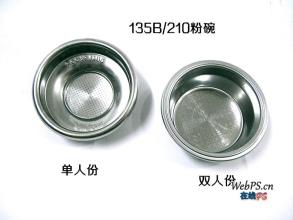Coffee flavor tasting: where does the "bitter" and "sour" in coffee come from?
Bitter taste:
Caffeine is the best known bitter ingredient in coffee, but caffeine actually accounts for up to 10% of the bitter taste. This can be understood from the fact that the concentration of caffeine in roasted beans is not affected by the degree of roasting, and that non-caffeine also tastes bitter. So where does the remaining 90% of the bitterness come from?
One of the sources of coffee bitterness is brown pigment. Brown pigments can be classified according to molecular size, and the larger the molecule, the stronger the bitterness. In the case of coffee, deep roasting increases the brown pigment, and so does the pigment with larger molecules (stronger bitterness). When cooking deep baked beans in daily life, you will find that the bitter taste is stronger, and the taste is more rich, which should have the same experience.
In fact, the bitterness intensity and taste of Arabica species are different from those of Congo species. This is also due to the difference between the amount and molecular size of brown pigment. Congo species contain lower oligosaccharides than Arabica species, do not caramelize, and are easy to produce pigments with larger molecules, so even light baking tends to taste rich bitterness.
Another source of bitterness is the seven diamino acid cyclized derivatives produced when amino acids and proteins are heated. This is a substance formed by the combination of two amino acids, and different ways of binding will result in different intensity of bitterness. In addition to coffee, part of the bitterness of cocoa, black beer and so on is also made up of this substance.
So, is the intensity and intensity of bitterness uncontrollable? Yes, of course. The bitterness can be changed as long as the type, baking degree, baking method and extraction method of coffee beans are changed.
Sour taste:
Raw beans contain citric acid, malic acid, quinic acid and phosphoric acid, which are related to sour taste, but these are not the sources of sour taste felt when drinking coffee. The acid caused by baking is the main source of sour taste.
As soon as raw beans are baked, chemical reactions occur in various ingredients, creating new acids. The most representative is the reaction of quinic acid after chlorogenic acid decomposition and the volatile formic acid and acetic acid reaction after oligosaccharide decomposition.
These chemical reactions during baking will cause the longer the baking is coaxed, the more the total amount of acid will increase. In other words, in the middle of baking, the sour taste will become stronger, but if you stay in the high temperature, the acid will undergo thermal decomposition. After this stage, continuing baking will only gradually reduce the sour taste.
Baked beans contain the most acid, the quinic acid that is added as a result of baking. Not only the content increases, but also the sour taste, which is commonly known as the main sour ingredient of coffee. Others, such as citric acid, acetic acid, phosphoric acid and so on. The sour intensity and concentration of each acid are different, so the simple sour taste is actually quite complicated.
The total amount and proportion of ingredients that cause the sour taste of baked beans will also be affected by the composition of raw beans, so the choice of raw materials will affect the way of sour taste to some extent. For example, the Congolese species has a low content of oligosaccharides, which are the source of acetic acid, so there is no volatile refreshing acidity.
In addition, the presentation of sour taste will also change due to the state of quinic acid. There are substances in quinic acid that show sour taste, and substances that cover the parts associated with sour taste (the state is like clasping your arms and covering your hands under the sour part) to avoid sour taste. The reason why the brewed coffee gradually turns sour is to avoid the sour substances gradually loosening their arms in hot water and releasing the sour taste.
Source: country of coffee
Important Notice :
前街咖啡 FrontStreet Coffee has moved to new addredd:
FrontStreet Coffee Address: 315,Donghua East Road,GuangZhou
Tel:020 38364473
- Prev

The main points you must know as a barista introduce the necessary knowledge to be a qualified barista
The proportion of SCAA fine cup coffee defined by the Gold Cup Fine Coffee Association of the United States and the scae European Fine Coffee Association must be about 20% of the coffee extraction rate, while the TDS is about 1.1% to 1.3%. For Drip Filter dripping and brewing, how to extract the best coffee flavor is controlled by two variables: the extract of coffee powder and the concentration in a cup of coffee.
- Next

The difference between single and double powder bowls of coffee machine and the situation of coffee brewing
Several differences between single powder bowl and double powder bowl of coffee machine and the situation that will occur when brewing coffee 1. The difference in the capacity of single and double powder bowls: 8-15 grams of powder 2. The shape of single and double powder bowls is tapered with beveled small flat bottom. the double bowl is in the shape of a straight-edged wide flat-bottomed cup. 3. The difference between single and double powder bowl filter holes: the pore size of single powder bowl is smaller than that of double powder bowl, and the hole size of double powder bowl is slightly smaller than that of double powder bowl.
Related
- What is the meaning of lactic acid fermentation with coffee bean treatment?
- How to judge the state of foam by sound?
- How does the latte pull out the unicorn pattern? Come to get for a little trick to improve the flower pull!
- Will flower pulling affect the taste of the latte?
- Do you know the history of coffee?
- The difference between honey treatment and sun washing what is raisin honey treatment?
- What kind of milk can a novice use to make coffee foam to keep the foam longer? The correct method and skills of milking tutorial sharing
- Why do washed coffee beans taste sour? Flavor characteristics of washed Coffee
- Introduction to the skill of how to practice the size and height of water injection around the circle of hand-brewed coffee
- How do beginners practice coffee flower drawing from scratch?

